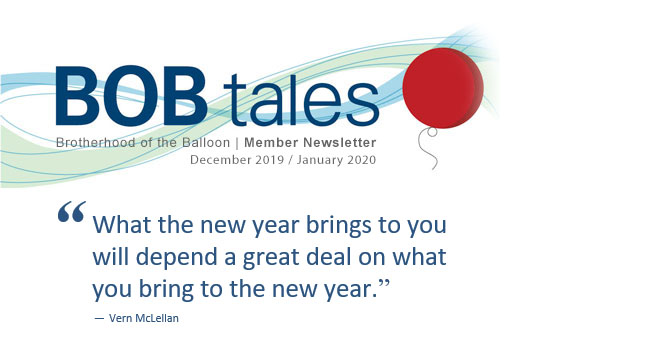
Dear Members (a note from Bob Marckini):
What do the following things have in common?
Cancer incidence in veterans; mushrooms; Alzheimer’s; Medicare; urine testing; smoking; Johns Hopkins; insurance denials; and a souped-up 1966 Chevy Corvair
Answer: They are just some of the topics covered in this month’s BOB Tales.
I remember when we started our five-page monthly newsletters 19 years ago. My biggest worry was that we’d run out of things to write about after a few months. That was certainly never the case.
With members from all over the world sending us links to articles on important topics, to our multiple subscriptions to prostate- and proton-related news outlets, and our daily incoming “Google Alerts” … our biggest problem is keeping the BOB Tales under 20 pages. We failed this month, but we have an excuse: This is the year-end holiday season two-month edition.
We’ve mentioned in previous newsletters that we communicate with members regularly by email and phone. And we reach out to contact those who make contributions to our favorite charities, which we talk about in this edition. One common theme in our communications is that everyone we talk with tells us they truly enjoy the BOB Tales and they look forward to every edition. That makes this enormous effort all worthwhile.
I’ll keep the opening memo short this month because there’s so much important material in the body of this month’s BOB Tales. I hope you’ll click through to read the entire newsletter, which includes some great humor, “odds & ends,” and one of our toughest-ever brain teasers.
Deb and I have much to be thankful for this year and we know most of you do as well. As we end 2019, we both wish you all a happy Thanksgiving, merry Christmas, happy Hanukkah and a very happy and healthy New Year. And be sure to look for our next BOB Tales; we’ll be making an important announcement.
As always, we welcome your input and feedback. Just send an email to [email protected].
Bob Marckini
To print the BOB Tales newsletter or view the newsletter with a larger font size, click here for the PDF file.
In this Issue:
- Medicare Patients Could Lose Access to Advanced Cancer Treatment
- Urine Test Might Dictate Prostate Cancer Treatment
- Getting a Second Opinion on Your Pathology Report
- New Data Show Rise of Cancers in Veterans
- New Imaging Method Could Guide Prostate Cancer Treatment
- Tips on Appealing an Insurance Denial
- Mushrooms May Help Protect Against Prostate Cancer
- Deep Sleep May Help Prevent Alzheimer’s Disease
- One of the Most Important Things for Health

Medicare Patients Could Lose Access to Advanced Cancer Treatment
Daniel E. Smith, executive director for the Alliance for Proton Therapy Access, recently wrote an op-ed for FierceHealthcare. He began with this: “Three of the scariest words in the English language are: ‘You have cancer.’” We agree.
Not so long ago, these three words most likely meant you were going to die. And if not, you’d suffer through grueling treatments and life would never
be the same. But today there are new treatments and technologies that are helping patients not only survive, but thrive after cancer.
However, as you know, the Centers for Medicare and Medicaid Services (CMS) is proposing a new rule that will make it harder for cancer patients to access one of the most technologically advanced, life-saving, healthy tissue-sparing treatments – proton therapy.
Smith states, “In its proposed rule, CMS not only fails to include the well-established guidelines from the American Society of Radiation Oncology and the National Comprehensive Cancer Network, it cites an outdated (2014) report from the Institute for Clinical and Economic Review and a flawed Medicare Patient Advisory Commission report, in which authors cited old data and ignored clinical expert opinions.”
CMS’ rationale for bundling proton therapy with traditional radiation treatments may be based on short-term cost savings rather than the most effective treatment for cancer patients. The proposed rule may actually increase costs down the road as patients may need treatment for long-term side effects and secondary cancers later in life.
With the rulemaking process in its final stages, we’re hopeful that Congress will pressure CMS to either remove proton therapy from the proposed model or modify the rule to ensure proton therapy is reimbursed at a rate that allows patients to continue receiving the treatment.
If you haven’t contacted your state senators and representatives, we implore you to fill out this form, write a letter, or make a phone call today. Find your senators here and your state representatives here.
Urine Test Might Dictate Prostate Cancer Treatment
Researchers in the UK report they’ve come up with a urine test than can predict the aggressiveness of prostate cancer. The test is called PUR, or prostate urine risk test. The test identifies men who are up to eight times less likely to need treatment within five years of diagnosis.
Most doctors agree that many prostate cancers are slow growing and don’t need aggressive treatment. So, when men choose active surveillance, they typically need regular tests including blood tests, digital rectal exams, MRIs and biopsies.
The PUR test can identify 35 out of 167 expressed genes that can accurately predict how dangerous a prostate cancer might be.
Dr. Manish Vira, vice chairman for urologic research at Northwell Health’s Institute for Urology in Lake Success, NY reviewed the study and said, “The PUR test has the potential to identify potentially aggressive prostate cancer earlier than traditional assessments in patients with low-risk disease.” He further stated, “While certainly the results are exciting, the test needs to be validated in a larger group of patients.”
The study was published in BJU International, and recently reported in WebMD News.
Getting a Second Opinion on Your Pathology Report
Getting a second opinion on medical results is always wise. Many believe this is not necessary when it comes to biopsy pathology results. Not true. We have seen many instances where prostate pathology results were changed when read by a second, more experienced pathologist. In fact, two men who read Bob Marckini’s book, took his advice, had their slides read by Dr. Jonathan Epstein’s lab at Johns Hopkins and learned they had no cancer at all. Both these gentlemen wrote reviews of Bob’s book on Amazon.
While results like this are extremely rare, it’s not rare for the second, more experienced pathologist to change the results. This is particularly important when reading prostate biopsy slides, because the recommended customized treatment is heavily influenced by the Gleason score reading of the biopsy. This action can range from active surveillance (no treatment at all) to a combination of aggressive treatments, including hormonal therapy. In our experience, a second opinion from one of the premier pathology labs changes the staging results roughly 30 percent of the time. This is significant.
Under-staging biopsies can be just as damaging as over-staging for obvious reasons.
In an article in the New York Times, from June 2017, Gina Kolata reported just how often there are mix-ups of samples sent to laboratories. “In these situations, the correct results were delivered, but to the wrong doctor or patient with the wrong patient name attached to the report.” In one study, 31 of about 6,700 blood samples were switched and the results were delivered incorrectly.
Cancer ABCs Inc. recently reported on this subject with a strong recommendation to get a second opinion on biopsy pathology results. The article states, “Don’t let a doctor or a hospital tell you that you cannot send your slides or tissue block to another lab. Your tissue is your personal property.” They also provide specific instructions in the article on how to package and ship your slides to one of three premier pathology labs in the U.S.: Johns Hopkins, Bostwick Laboratories, and Dianon Laboratories. In most cases, a urologist should willingly ship your pathology slides to a lab of your choice.
New Data Show Rise of Cancers in Veterans
According to a recent McClatchy Washington Bureau investigation, veterans saw a spike in urinary, prostate, liver, and blood cancers during nearly two decades of war. Some military families question whether their exposure to toxic environments is to blame.
McClatchy found that the rate of cancer treatments for veterans at Department of Veterans Affairs health care centers increased 61 percent for urinary cancers from fiscal year 2000 to 2018. The rate of blood cancer treatments rose 18 percent in the same period. Liver and pancreatic cancer treatment rates increased 96 percent and prostate cancer treatment rates increased 23 percent.
McClatchy analyzed billing data for veteran visits involving a cancer diagnosis at VA medical facilities from fiscal year 2000 to 2018. A more in-depth methodology of the review can be found here.
The VA Disagrees with McClatchy’s Approach
When McClatchy presented its findings to the VA, the agency said it disagreed with the company’s approach. They said an analysis of billing data would create an overcount, and that its internal cancer registry system did not show a significant rise.
Rachel Ramoni, chief research and development officer for the VA, said despite generations of men and women returning home from serving in wars overseas to face cancer diagnoses at home, the agency has not devoted resources to discover the root causes. She committed the VA will make major investments in studying toxic exposure in fiscal year 2021.
In regard to prostate cancer, “We don’t have a clear answer why,” Ramoni said. “I think it’s clear that Agent Orange alone can’t be the explanation because that affects one era of service. But in general, cancer is more common in VA across the board than it is in the U.S. general population.”
New Imaging Method Could Guide Prostate Cancer Treatment
An imaging method called hyperpolarized MRI can produce highly detailed pictures of a tumor’s metabolic activity. A new study demonstrates this approach can give clues about whether a prostate cancer is likely to spread, which could guide treatment decisions.
To diagnose and treat cancer effectively, researchers need to learn about a tumor’s size, location, and metabolic activity. Some imaging techniques do this by focusing on the way cancer cells process nutrients. For example, tumors absorb more glucose (sugar) than normal cells. After giving a patient a small amount of radioactive glucose, doctors can see the location of cancer cells as well as their metabolism on a PET scan.
The hyperpolarized MRI takes this approach a step farther and provides a highly detailed picture of a tumor’s metabolic activity. The laboratory of Kayvan Keshari, a Memorial Sloan Kettering biochemist and imaging specialist, is investigating the use of HP MRI to show how tumors respond to treatment. In recent years, they established that this approach can work to image prostate cancer and brain tumors.
Tips on Appealing an Insurance Denial
When your health insurer denies coverage for proton therapy or simply tells you they don’t cover the treatment, you may think your hands are tied. However, this may not be the case.
Obtaining coverage or pursuing an appeal takes time and effort, but it isn’t necessarily impossible to overturn a denial. First and foremost, it’s important to stay focused on the necessary steps in the process instead of letting your emotions get to you. You’re probably frustrated, but don’t assume this is war. Your goal is to prove your insurer is contractually obligated to pay for your proton treatment.
Make Your Argument
Present a logical argument and put everything in writing. Although you may want to get on the phone immediately, you must leave a paper trail. Make sure to take time to scrutinize the denial letter before you respond. Determine if the basis for denial is that proton therapy is considered experimental/investigational or not medically necessary or both. Next, (1) obtain a copy of your health plan or insurance policy and (2) determine how many days you have to appeal the denial decision. Typically you will have up to 180 days.
Levels of Appeal
There may be several levels for appeal depending on your governing health plan or insurance policy. One thing you should advocate for, unless your provider already offers this, is a recorded peer-to-peer phone review between your doctor and a doctor associated with the insurer. Most insurers already offer this, however very often the insurance company’s doctor is not qualified to be rendering an opinion on your prior authorization request or claim. Make sure the insurer’s doctor is a radiation oncologist.
If a peer-to-peer discussion is unsuccessful, file an internal appeal and request it be reviewed by an insurance company medical director. If this is denied, request an independent external review with a third-party board-certified physician.
Throughout the appeal process, it’s critically important to be organized. Document every call and email, and keep every piece of paper you receive related to your claim. Also consider putting together a timeline beginning on day one. Make sure to write down the appeal deadlines and tick them off when you meet them.
Writing an Appeal Letter
The focus of your appeal letter is to explain why the insurance company’s decision to deny coverage is wrong. Include your medical records from your provider (such as case notes and a supporting letter explaining why treatment is necessary) and test results. Also include articles, studies and information from experts (such as scientific journal articles) for additional support.
Describe your medical condition briefly and the impact it has had/could have on your life. Your letter should be pleasant and thorough but succinct. It’s important to not convey your frustration or make threats.
Ask your provider to review your letter and make any revisions necessary. Make sure he/she also submits his/her own letter of support. Send everything by certified mail and request a return receipt.
If Your Appeal Fails
If internal and external appeals fail to overturn your insurer’s decision, you’re not necessarily out of options. Talk with your doctor and call your proton center insurance appeal team for further assistance. At this time you may also consider hiring an attorney. Many law firms that do this type of work operate on contingency. This means they seek their fees only from a settlement they obtain for you. They may also be able to obtain their payment directly from the insurance company. For a list of attorneys that have won these types of trials and/or are knowledgable about proton therapy litigation, please send an email to [email protected].

Another Deluge of Responses from Members After Second Email Blast Regarding Medicare Proposed Rule
We issued our second and final email blast to members on Nov. 5, imploring you to contact your Congressional leaders and ask them to implore CMS (Center for Medicare and Medicaid Services) to reconsider a proposed coverage model that would reduce coverage levels for proton therapy by roughly 50 percent. Again, we were inundated with emails in response.
We’re honestly blown away by the continued support of our members and can’t thank you enough for the time and effort you’ve taken to fight this potentially devastating change in coverage. We’ve included a few more snippets from some of the many emails we received.
I wrote to my MO state representatives. Here’s an excerpt from my letter:
I implore you to pressure CMS to revisit the proposed rule and revise its mischaracterization of proton therapy as low value. It’s quite the contrary, in fact: Proton therapy is highly valuable – I’m proof of that. Proton therapy cured my cancer and maintained my quality of life.
My twin brother was diagnosed with prostate cancer in 2005 at the age of 60. He had conventional open surgery and suffered for the following year with recurring blockages of the urethra at the bladder suture. After six emergency catheterizations and laser surgeries to open the blockages, he went to the Mayo Clinic to find an answer to his problem. He was put on a regime of self-catheterizations, which ultimately solved the problem, but with much pain and suffering. To this day, he still has stress incontinence and impotence.
Nine months after my brother’s surgery, I was diagnosed with prostate cancer. After watching my brother’s harrowing experience, I consulted some of the leading practitioners of each therapy around the country to find a better treatment. I decided on proton therapy at Loma Linda University Cancer Center. I made this decision because I was convinced that it afforded me the best chance for a quality life after treatment.
The treatment was totally painless and problem-free. Twelve years later, I have a PSA of 0.3 and full urinary and erectile function. I have met scores of men treated with protons and invariably hear the same success story that I tell.
I sent a message through the Alliance for Proton Therapy’s form to my state representatives in Oregon. I told them my proton treatment was a dream … I feel very lucky to have had the chance to be treated with proton therapy … I suffered no side effects whatsoever, including my time in treatment. My PSA since then has consistently been less than 0.1.
Also, I recently had a routine colonoscopy, and the doctor told me that there was very little evidence of my proton treatment inside my colon, especially compared to what he has seen with other modalities. I have a clean bill of health, I feel good (in fact, excellent, for 75), and look forward to my remaining retirement years. Thank God for all the good folks at Loma Linda for seeing me through this journey.
Thank you, Deb, and the Alliance for Proton Therapy, for the quick and easy way to send my message to state reps. You guys are great!
I sent my letters in. I hope all 10,000 members do the same – especially if they’ve got brothers and sons. I would think they’d want access to proton therapy preserved so that, if diagnosed, their family members could benefit from the same non-invasive, organ-sparing treatment they benefited from. In fact, I hope all 10,000 members had their brothers and sons write in too!
Thank you, BOB, NAPT and others for your tireless efforts on this campaign to fight Medicare. It’s a shame how these days people care only about saving money. What’s ironic is that with this new rule, Medicare will inevitably end up spending more money on patients who need follow-up treatments when traditional radiation causes unnecessary side effects and secondary cancers. Seems ridiculous to me.
I wrote emails, letters and made a few phone calls. I’m probably driving some folks crazy. But here’s my argument: Proton therapy has been proven time and time again to be the best treatment for pediatric cancers because protons can be precisely controlled to target tumors without reaching other healthy growing tissues. Take the brain, for example. A child’s brain is still growing and developing, so if you irradiate it, it can’t continue to grow and develop as it normally would. Over time, this could lead to devastating side effects. So, a) why on earth would you do anything to limit access to proton therapy in general, which would affect all people, including children, and b) why wouldn’t you take the pediatric example and understand proton’s ability to spare healthy tissues in any person, at any age, with any type of cancer?! Seems ridiculous to me to think otherwise.
How Are They Now?
Paul: Treated 16 years ago at age 63…
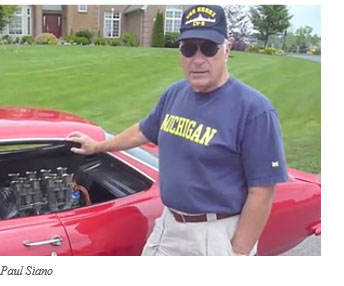 Paul Siano probably had little choice about his favorite hobby. He grew up in Michigan, the car capital of the world, during the “golden age” of the automobile. He spent more than a few high school study halls trying to draw the perfect car. During his Navy days he purchased a new VW in Gibraltar and brought it back on his aircraft carrier so that later he could install a supercharger. His next car was a new turbocharged Corvair followed by another turbocharged Corvair which he still owns.
Paul Siano probably had little choice about his favorite hobby. He grew up in Michigan, the car capital of the world, during the “golden age” of the automobile. He spent more than a few high school study halls trying to draw the perfect car. During his Navy days he purchased a new VW in Gibraltar and brought it back on his aircraft carrier so that later he could install a supercharger. His next car was a new turbocharged Corvair followed by another turbocharged Corvair which he still owns.
After receiving word that he had aggressive prostate cancer (Gleason 9) in 2004, Paul wasn’t sure how long he’d be around. Fifteen years after proton treatment at LLUCC, he’s feeling fine; his PSA is “so low it didn’t even get discussed at my yearly appointment recently;” and he still “plays with cars.” Last month, two of Paul’s cars were part of the Black Diamond Invitational Car Show in his home state of Florida.
“It seems the older I get the happier I get,” Paul said.
If you’re a car enthusiast, you may want to check out this video of Paul and his V-8 Corvair.
Ron: Treated 8 years ago at age 60…
 Ron Nelson’s beloved mother-in-law passed away three months after he completed proton therapy for prostate cancer at UFHPTI in 2011. On that day, Ron inherited Baxter, a perky 27-pound mutt who kept her company in her final years. Baxter and Ron have been best pals ever since. “He’s taught me a lot about life—lessons that are particularly valuable in my post-proton, post-cancer existence,” Ron said. “We’re just a couple of dogs muddling through life.”
Ron Nelson’s beloved mother-in-law passed away three months after he completed proton therapy for prostate cancer at UFHPTI in 2011. On that day, Ron inherited Baxter, a perky 27-pound mutt who kept her company in her final years. Baxter and Ron have been best pals ever since. “He’s taught me a lot about life—lessons that are particularly valuable in my post-proton, post-cancer existence,” Ron said. “We’re just a couple of dogs muddling through life.”
Ron, 68, says he’s doing well “for a man my age.” In addition to regularly speaking with newly diagnosed prostate cancer patients to help them along their journey, Ron writes The After Proton Blog and occasionally speaks about proton therapy at UFHPTI’s prostate cancer clinics. He’s also made presentations for the UFHPTI’s board of directors, the IBA international leadership team in Brussels, the NAPT conferences, and the USTOO support group in Greenville, SC. Ron has also contributed his thoughts at the COMPPARE workshops in Amelia Island, FL and written a book about his journey through prostate cancer and proton therapy.
If you didn’t think that was enough proton advocacy, Ron and his wife, Lucy, also host a “proton party” at their home in Irmo, SC each fall. Guests come from North Carolina, Georgia, and Florida.
When he’s not advocating for proton therapy, Ron plays guitar, swims and paddle boards on a nearby pond, works on his computer, and enjoys time with extended family—four daughters and sons-in-law, seven grandkids, his 96-year-old mom, and “the best wife ever.”
“Life doesn’t get much better,” Ron said. “Oh, and by the way, no cancer and no side effects. I’m a happy camper!”
Steve: Treated 6 years ago at age 57 …
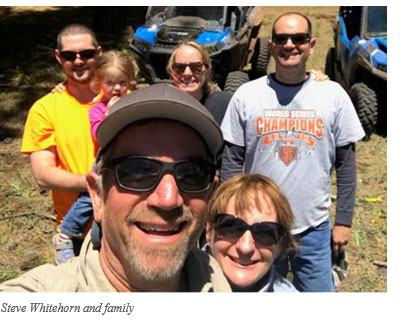 We connected with Steve Whitehorn last summer after he’d backpacked with his family near Yosemite, a tradition going back 50 years. He and his wife Lisa were then headed to Alaska for three weeks “to visit the out-of-the-way locations less traveled.”
We connected with Steve Whitehorn last summer after he’d backpacked with his family near Yosemite, a tradition going back 50 years. He and his wife Lisa were then headed to Alaska for three weeks “to visit the out-of-the-way locations less traveled.”
We were pleased to hear from Steve again last month. He’d just finished another backpacking trip on the Pacific Crest Trail in Northern Yosemite with his family and friends. Steve said he’s feeling great and has had no health issues related to his prostate cancer. In addition to more outdoor outings with Lisa, he’s awaiting the birth of his fourth grandchild due in early 2020.
Regarding the BOB Tales newsletter, Steve said, “Your newsletter is amazing. The intros are so well written. I can’t thank you enough for your thoughtfulness. The articles you include are so varied and relevant to all of us. I can’t wait for the next time someone asks me about my prostate cancer treatment experience to refer them to the BOB website as I always do. Your work is very much appreciated!”
Charles: Treated 5 years ago at age 45
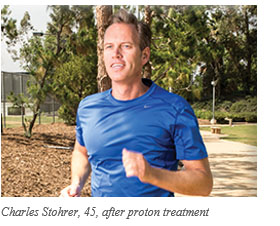 When Charles Stohrer was diagnosed with prostate cancer on Feb. 9, 2014, he was shocked. He didn’t have any symptoms; he was in great shape; and suddenly a blood test revealed he had cancer. At just 45 years old, Charles was in the prime of his life – a senior design manager and an active athlete with a beautiful girlfriend.
When Charles Stohrer was diagnosed with prostate cancer on Feb. 9, 2014, he was shocked. He didn’t have any symptoms; he was in great shape; and suddenly a blood test revealed he had cancer. At just 45 years old, Charles was in the prime of his life – a senior design manager and an active athlete with a beautiful girlfriend.
He was fortunate that a friend of his had been treated with proton therapy 14 years earlier and he was doing great. Following a conversation with him, Charles booked a flight to LLUCC in California from his home in Michigan.
During his proton treatment, Charles worked out every day and took part in many patient activities. His girlfriend, Laura, also flew out to spend time with him.
 When we spoke with Charles last month, he said, “Life is good.” He’s a global senior design manager and still with Laura. He loves sports cars, snowboarding, and spending time with friends. Charles also loves traveling. “In 2018, Laura surprised me with a trip to Tahiti to celebrate my 50th,” he said. The two have also recently traveled to Mexico, France, and the UK and are planning a trip to Alaska. “I’m living the life after protons,” Charles said.
When we spoke with Charles last month, he said, “Life is good.” He’s a global senior design manager and still with Laura. He loves sports cars, snowboarding, and spending time with friends. Charles also loves traveling. “In 2018, Laura surprised me with a trip to Tahiti to celebrate my 50th,” he said. The two have also recently traveled to Mexico, France, and the UK and are planning a trip to Alaska. “I’m living the life after protons,” Charles said.
Charles still talks to the friends he made during his treatment and volunteers to be a reference on our “Young Men” former patient reference list.
Read Charles’ full testimonial on our website. He was also featured in a TV commercial for LLUCC.

Recap: Pacific Northwest Proton Reunion
BOB member Elten Zerby and his wife, Paula, hosted the 8th annual “Pacific NW Proton Reunion” at their home in Kelso, WA (one hour north of Portland) last month. They invited local BOB members and their significant others to join an Italian-themed dinner complete with décor, games, and prizes. The next event is already scheduled for October 2020.
In attendance was one of our good friends, BOB member Ron Hendricks, Director, U.S. Foundation for Trinity Western University, who contributes the “Estate Planning Hints” articles we publish regularly in our newsletter. He brought his wife, Karen, also a good friend of ours. Pat Purcell and his wife, Sharon, also attended. You may recognize them from our website; The Purcell “Against All Odds” video appears on almost every page. It documents Pat’s journey through prostate cancer and proton therapy at LLUCC. View the video here.
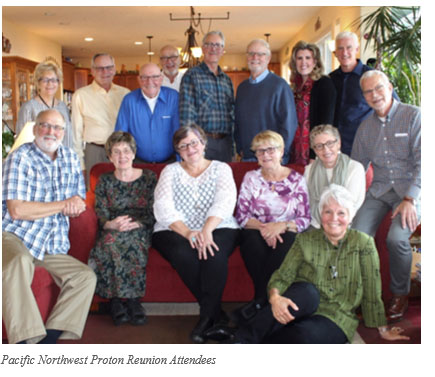

Mushrooms May Help Protect Against Prostate Cancer
If you like mushrooms, you’re in luck. A new study, the first of its kind, published in the International Journal of Cancer found that the fungi may help prevent prostate cancer.
Researchers studied 36,499 Japanese men, ages 40 and 79, over a period of 13 years. They found that those who ate mushrooms once or twice a week had a 9 percent lower risk of prostate cancer. If they ate mushrooms three or more times a week, they had a 17 percent lower risk. Although the size of the effect is relatively small and it’s unclear which type of mushrooms may be beneficial or why they may have a protective effect, these findings are likely to inspire further investigation.
Deep Sleep May Help Prevent Alzheimer’s Disease
There are lots of reasons for getting a good night’s sleep. Sleep helps reduce stress, improve memory, lower blood pressure, strengthen your immune system, help maintain proper body weight and put you in a better mood. But new research suggests getting adequate sleep also could help stave off Alzheimer’s disease.
When researchers looked at the relationship between sleep and Alzheimer’s, they found that during deep sleep, the brain goes through a self-cleaning process that can remove toxins associated with the disease.
But not all sleep helps prevent Alzheimer’s. Only deep – non-rapid eye-movement – sleep can produce the slow brain waves that help clear toxins.
Researchers concluded that people may be able to reduce their risk of Alzheimer’s by making sure they are getting enough high quality, deep sleep.
For those, who have been diagnosed with obstructive sleep apnea and are not using their CPAP equipment, this could be a warning that they may be at higher risk of developing Alzheimer’s disease.
One of the Most Important Things for Health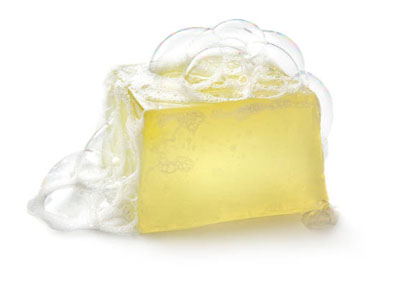
From syndicated columnist, Dr. Keith Roach
Washing our hands is one of the easiest and most important things we can do for our health. According to the Centers for Disease Control and Prevention, “Handwashing can prevent about 30 percent of respiratory infections.”
“When washing, lather on the soap and scrub your hands for at least 20 seconds under running water. It doesn’t matter whether the water is warm or cold,” Dr. Roach says.
Tips to Avoid Food Poisoning
From the U.S. Centers for Disease Control and Prevention
 The CDC estimates that 48 million people get sick from foodborne illnesses each year. And this can be prevented 95 percent of the time by handling food smartly. Here are some tips:
The CDC estimates that 48 million people get sick from foodborne illnesses each year. And this can be prevented 95 percent of the time by handling food smartly. Here are some tips:
· Use a plastic (not wooden) cutting board for meat and fish. Clean in dishwasher and don’t use the cutting board for other foods.
· Don’t leave perishable food sitting at room temperature for more than 20 – 30 minutes.
· Use warm, soapy water to wash kitchen countertops.
· Use a scrub brush to wash dishes. If using dishcloths, change them out daily. Sponges should dry completely between uses.
· Do not reuse utensils and plates that have been in contact with raw meat without washing them first. It’s common for people to carry raw meat to the grill on a plate with utensils (fork, spatula, etc.) and then use the same plate and utensils to transfer the cooked meat from the grill to the kitchen.

A Note from Bob Marckini
We charge no dues for membership in our group. Our members repeatedly tell us we provide considerable value to them through the various programs we’ve established over the years, including our website, member testimonials, 40 former proton patient reference lists, medical insurance support and documentation, surveys, our PowerPoint presentation, response to emails and phone calls, and especially our comprehensive 20-plus page newsletters with timely information about new developments in prostate cancer prevention, detection, treatment, as well as the latest developments in proton therapy for treating prostate cancer and other diseases.
If you feel these efforts have been of value to you and would like to acknowledge them in some way, I urge you to consider three things:
- Making a year-end gift to the Robert J. Marckini Chair for Proton Research at Loma Linda University Cancer Center;
- Making a year-end gift to Loma Linda’s Vision 2020 – a campaign to improve clinical care by expanding the children’s hospital tower and adult hospital, education to provide training, and increase endowments and scholarships for students, and research to transform health care and continue to search for new ways to improve health around the world.
 Putting Loma Linda University Health in your estate plan. My wife, Pauline, and I make a gift every year and we’ve included Loma Linda University Health
Putting Loma Linda University Health in your estate plan. My wife, Pauline, and I make a gift every year and we’ve included Loma Linda University Health
in our estate plan. This is our way of saying “thank you” for all we’ve received from our association with Loma Linda University Health. If you’d
like to learn more about planned giving
write to [email protected].
Thank you.
More Ways to Give to Proton Therapy Research
- Donate online.
- Write a check to LLUCC Proton (Put “Marckini Chair” on the memo line) and mail it to LLUH, Office of Philanthropy, P.O. Box 2000, Loma Linda, CA 92354.
- Call Regina Joseph at 909-558-5010.
More Ways to Give to Vision 2020
- Donate online.
- Write a check to LLUH Vision 2020 and mail it to LLUH, Office of Philanthropy, P.O. Box 2000, Loma Linda, CA 92354.
- Call 909-651-2020.

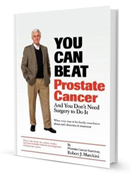
Amazon Visibility
There are more than 3,000 prostate cancer related books on Amazon. Dr. Patrick Walsh’s Guide to Surviving Prostate Cancer is ranked #1. Dr. Walsh is considered by many to be the “guru of surgery.” His book has 443 reader reviews, averaging 4.7 out of five stars. Bob’s book is ranked #5 on Amazon – a pretty good place to be – and it has 393 reviews averaging 4.9 out of five stars. So we’re not too far behind.
If you haven’t already, we encourage you to write a review of Bob’s book on Amazon. Please help us help others find their way to proton therapy. Let others learn there are alternatives to surgery.
Feedback from UFHPTI
Several proton centers send Bob’s book to patients who make inquiries about proton therapy for their prostate cancer. We’ve heard from them that newly diagnosed men and their families love the book and many have chosen proton therapy after reading it. Following is a note we received last month from the intake people at the University of Florida Health Proton Therapy Institute:
We receive feedback daily about how helpful your book is to men exploring treatment options. In fact, a few years ago, the spouse of a patient asked for an entire box of books to hand out as Christmas presents to her family.
Recent Amazon Review
We read and appreciate every Amazon review. Here is a great one from July 30. Thank you for your review, Donald!
 A Must Read: I read Robert Marckini’s book cover to cover. The book is filled with information on all types of prostate cancer treatments, but its primary focus is proton radiation therapy. Robert clearly put a lot of time into his research, and his writing style is easy to read, and he doesn’t burden the reader with all the technical stuff. Thanks, Robert, for taking the time to write this book.
A Must Read: I read Robert Marckini’s book cover to cover. The book is filled with information on all types of prostate cancer treatments, but its primary focus is proton radiation therapy. Robert clearly put a lot of time into his research, and his writing style is easy to read, and he doesn’t burden the reader with all the technical stuff. Thanks, Robert, for taking the time to write this book.
Buy Bob's book online, in bulk, or in Spanish.
Online: Paperback: $19.00--•--Kindle: $7.99--•--NOOK Book: $9.99--•--Apple iBook: $9.99
In Bulk: Conctact us for a discount price list. Proceeds from book sales support proton therapy research through the Robert J. Marckini Endowed Chair at LLUCC.
In Spanish: Buy the print version or in eBook format.
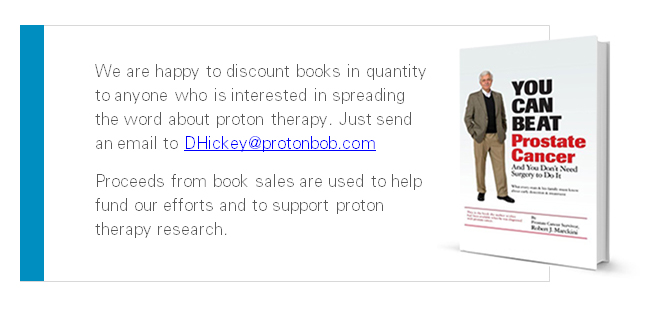

Estate Planning Hints
BOB Member Ron Hendricks is Director, U.S. Foundation for Trinity Western University. He regularly copies us on his “News from Ron” mailings, which are helpful hints on estate planning to the readers of his newsletters. We’ve found Ron’s suggestions to be timely and beneficial. With his permission we periodically share some of his wisdom with our membership. This segment is called …
Difficult Families
There are several ways a person could challenge your Last Will and Testament. He or she may claim that you have a lack of capacity, that there were unqualified or improper witnesses, or that there’s been undue influence that invalidates the will.
What Is Capacity? Capacity is a term that means you are qualified to sign a will. Fortunately, you do not lose capacity simply because you have a “senior moment” or a brief period of forgetfulness. Rather, your capacity is defined as (a.) your ability to understand that your will transfers your estate, (b.) that you know the general type and nature of your property, and (c.) you can identify the family members who are your potential heirs.
What Questions May the Attorney Ask? Your attorney will be very interested in making certain that the will is properly signed and qualified to transfer your property. He or she may ask general questions to enable you to show that you are qualified to sign the will.
What is Undue Influence? As we become more senior, we tend to have less physical and mental strength. The action of a child or caregiver in causing us to sign a will that reflects his or her intent rather than our intent is call “undue influence.”
Summary: Your will is designed to carry out your intent. If you sign a new will in your very senior years when you are not in the strongest mental and physical health, it can still be valid and upheld. However, taking a few commons sense steps to increase the likelihood that there will not be a contest by a difficult family member is quite easy and good judgment on your part. Please contact a qualified attorney to minimize your risk should you have someone challenge your will.
LLUH Nurse Honored for Donating 113 Gallons of Blood, Inducted into Nat’l Donation Hall of Fame
Dexter Emoto, RN, a post-anesthesia care unit and recovery room nurse at Loma Linda University Health, has been inducted into the national Fresenius Kabi Donation Hall of Fame for his blood donations. He started donating his blood 45 years ago while he was attending Pacific Union College in California’s Napa Valley.
Over the years, Emoto has donated more than 113 gallons of blood, making him one of the highest blood donors in the western U.S. His blood has helped nearly 1,500 individuals, estimates Lifestream.
Since graduating from nursing school in 1977, Emoto has worked as a nurse – as well as a mentor for student nurses – with Loma Linda University Health. “I want future nurses to know that the blood they hang is coming from a volunteer,” Emoto says.
BOB Member Also Donates Blood Regularly
BOB member, Bob Hawley, who happens to be our professional newsletter editor, has also been donating blood for many years. “I just got my 35-gallon pin,” he said. “
A few years ago, when a Portland BOB reunion was organized by local men, they surprised Bob by having someone from the Red Cross present him a framed award at the event. “That was a few gallons ago,” Bob said.
 Bob Hawley gives in other ways, too. He began contributing to the Robert Marckini Chair for proton research at LLUCC when he started selling BOB bumper stickers. The stickers read “Prostate Cancer? www.protonbob.com.” They are $6.00 and proceeds go to the Marckini Chair.
Bob Hawley gives in other ways, too. He began contributing to the Robert Marckini Chair for proton research at LLUCC when he started selling BOB bumper stickers. The stickers read “Prostate Cancer? www.protonbob.com.” They are $6.00 and proceeds go to the Marckini Chair.
If you’re interested in buying a bumper sticker (What a great Christmas gift!), send $6.00 to Bob Hawley: P.O. Box 45, Mt. Angel, OR 97362 and he’ll mail you one.

Last Month’s Brain Teaser
Gaze at this sentence for just about sixty seconds and then explain what makes it quite different from the average sentence.
Answer: It contains all the letters in the alphabet.
 Winner: Our brain teaser winner is Don Denton of Bowling Green, KY. Don was treated with proton therapy at age 63 at UFHPTI in 2011. As an almost nine-year cancer survivor who had to fight his insurance company for coverage, Don is a passionate advocate for proton therapy and works tirelessly to help others battle their insurance carriers for coverage.
Winner: Our brain teaser winner is Don Denton of Bowling Green, KY. Don was treated with proton therapy at age 63 at UFHPTI in 2011. As an almost nine-year cancer survivor who had to fight his insurance company for coverage, Don is a passionate advocate for proton therapy and works tirelessly to help others battle their insurance carriers for coverage.
In 2014, Don founded the Tennessee Cancer Patient Coalition (TCPC) with the goal of gaining proton therapy insurance coverage for every Tennessean. He’s worked on various bills in the Tennessee legislature for the past five years.
Don is also a published author. He wrote Calming the Storm, a book about the spiritual, emotional, and physical experience of fighting cancer. He speaks to various groups about proton therapy, his personal diagnosis and experience, and the legislative and regulatory challenges he’s been involved with. Don also counsels newly diagnosed men about the advantages of proton therapy.
Most recently, Don’s been working closely with the Provision CARES Proton Therapy Center in Nashville to fight the Medicare proposed rule.
“I owe Bob Marckini a big thanks for educating and encouraging me to beat prostate cancer with proton therapy,” Don said.
New Brain Teaser
What do these words have in common?
Aluminum, center, licorice, maneuver, offense, rumor, specialty
We think this is a tough one! Send your answer to [email protected] for a chance to win a signed copy of Bob Marckini’s book, You Can Beat Prostate Cancer.
Some Laughs
Husband: Put your coat on, I’m going out.
Wife: You don’t normally take me with you.
Husband: I’m not – I’ve just turned off the heat.
Sergeant: I didn’t see you in camouflage class this morning, Private.
Private: Thank you very much, Sarge.
Man: Could you tell me where the self-help section is, please?
Librarian: I could, but that would defeat the purpose.
More Laughs …
Apparently, you can’t use “beefstew” as a password. It’s not stroganoff.
Bread is a lot like the sun. It rises in the yeast and sets in the waist.
Despite the high cost of living, it remains popular. – Sign at the Indian Hills Community Center
What did the duck say when it bought lipstick? “Put it on my bill.”
What's the best thing about Switzerland? I don’t know, but the flag is a big plus.
A man walks into a lawyer’s office and asks, “How much do you charge?” The lawyer says, “$5,000 for three questions.” “Wow, that’s pretty expensive, don’t you think?” The man asks. “Yes,” says the lawyer. “Now, what’s your third question?”
Questioning the Experts
If walking is good for your health, the mailman would be immortal.
A whale swims all day, eats plenty of fish, and drinks only water, but is still fat.
A rabbit runs, hops, and lives only 15 years, while a tortoise doesn’t run, does mostly nothing, yet lives for 150 years.
And they tell us to exercise? I don’t think so.
Quote of the Month:
"Though no one can go back and make a brand-new start, anyone can start from now and make a brand-new ending." - Scottish Theologian, Carl Bard

“Thank You” Never Seems Like Enough
At the end of every year, we write a special “Final Thought” to thank all who’ve helped us with this “ministry.” For years and years, there are so many of you who’ve written kind and supportive messages to us, thanking us for our hard work, complimenting our efforts, and encouraging us to continue. Those messages keep our hearts whole and our spirits up.
Many of you have taken time out of your busy schedules to volunteer your time to be contacted by newly diagnosed men and their family members. Many of you also write letters, op-eds, blogs, comments, and reviews in support of proton therapy in various media outlets. Some of you have contributed to our newsletter, thoroughly analyzing technical articles, reviewing books that may be valuable to our readers; allowing us to re-print interesting articles you’ve written for other publications; contributing your own personal stories, photos and videos. One of you takes hours out of every month to edit our 20-plus page newsletter! Those actions inspire and motivate us.
This year, we made new friends in law who help us support prospective proton patients who are struggling to obtain insurance coverage. The folks at the National Association for Proton Therapy (NAPT) and representatives from many of the proton centers also share information on insurance strategies and patient success stories. These relationships help us become a better resource to our members and prospective proton patients.
Our friends at NAPT also relay critically important information to us monthly during our conference calls. Furthermore, during what’s been an extremely busy few months dealing with the Medicare proposed rule, our many questions directed at NAPT in between monthly calls are answered within minutes by email or phone. Another huge champion for proton therapy –the Alliance for Proton Therapy Access – has hounded the press and provided timely information and simple ways to connect with state representatives. Our affiliation with these organizations builds us up and gives us the tools to fight harder for access to proton therapy.
The COMPPARE trial team has gone above and beyond to push this important study forward, working to gain approvals from the institutional review board, get sites registered and patients enrolled, launch a newsletter, educate its stakeholders and find and take part in relevant outreach activities. We’re honored and excited to be a part of this effort, and believe it will mean big, positive changes for proton therapy – and thousands and thousands of cancer patients – in the future.
Finally, to our family at Loma Linda University Cancer Center who support us in more ways than we have time or space to mention – we’re indebted to you for your unwavering commitment to this organization. Without you, we wouldn’t be.
 “Thank you” will never be enough to truly relay our appreciation for all of you. We hope you know how much we value you. We know that without your help, we wouldn’t be able to do what we do.
“Thank you” will never be enough to truly relay our appreciation for all of you. We hope you know how much we value you. We know that without your help, we wouldn’t be able to do what we do.
We wish you all a Happy Thanksgiving, a Merry Christmas, a Happy Hanukkah, and a season filled with peace, joy and good health. We hope the coming year will be overflowing with all the good things in life.
Low PSAs to all,
Bob Marckini and Deb Hickey
To print the BOB Tales newsletter or view the newsletter with a larger font size, click here for the PDF file.
NO MEDICAL ADVICE: Material appearing here represents opinions offered by non-medically-trained laypersons. Comments shown here should NEVER be interpreted as specific medical advice and must be used only as background information when consulting with a qualified medical professional.
